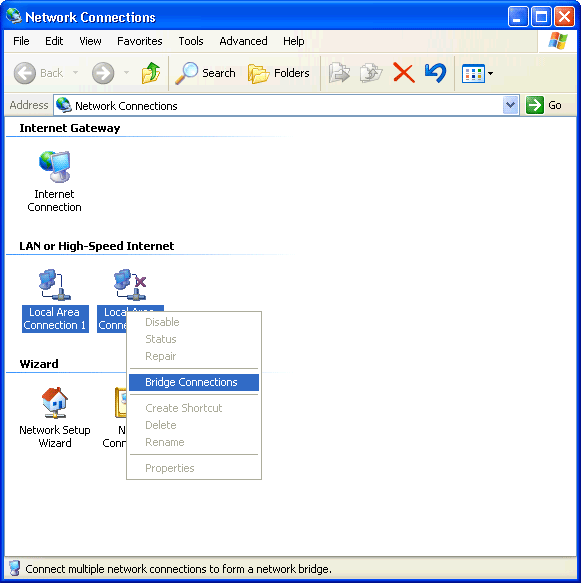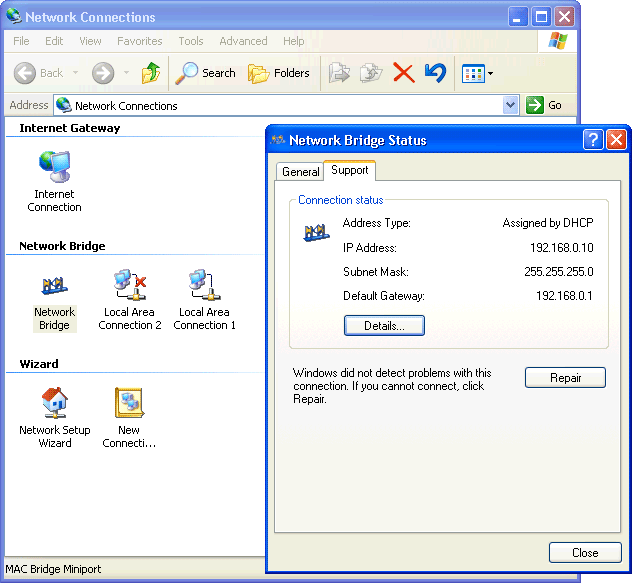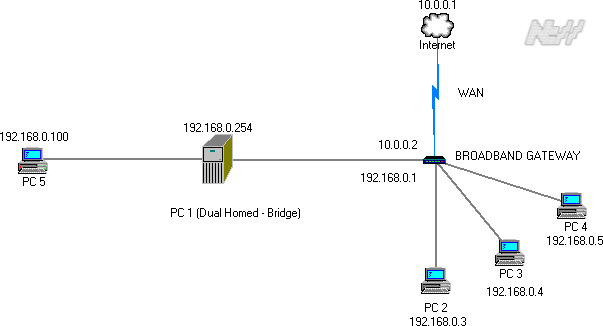Bridging - Windows Network Bridge
With Windows XP, a further Networking function was added: MAC Bridging.
This Feature bridges two or more Networking Connections to create a single 'Virtual' Network adapter that will allow all network frames to flow between the joined network adapters and their connected networks


To achieve the same functionality without this bridging feature, a user would have to purchase a costly Ethernet Bridge (which typically don't support, say FireWire Networking), or deploy software or an operating system to achieve the same function.
Advantages of bridging (with multiple network adapters)
- Allows networks to be joined in scenarios where extra cabling or operating an additional switch/hub may not be possible or practical.
- Allows segregation of networks to separate traffic flows
Disadvantages of bridging
- Connectivity is reliant on the bridge, if the bridge goes down or is ms-configured,external connectivity to nodes behind the bridge is lost
- Nodes behind a bridge are connected to the same network/subnet/workgroup as those in front of the bridge, which can have an impact on security or performance

For a home or small office scenario where Ethernet ports and may be limited and conduits for cables or patch panels non existent, Ethernet Bridging using the dual Ethernet ports available in a computer can become a useful solution to problems where alternative solutions are not practical .
Scenario Description
- A switch/hub is located within a central point within a premises, such as a closet,hallway,annex typically near the main broadband outlet . This may comprise of a dedicate switch/hub connected to a broadband modem or an integrated all in one unit, or a dedicated PC who's role it is to provide broadband or dial up Internet sharing to the local area network
- A single Networking cable is run from the switch to a single Ethernet jack in each room where connectivity is desired
- A user would then be able to connect a single computer to their personal Ethernet jack in each room.
Problem
This design proves quite satisfactory, unless the user wishes to connect additional network devices to their personal Ethernet jack.
Possible Solutions.
- Install Additional Ethernet jacks and additional cables
Since there is only one cable/jack in each room, installing additional cables/jacks and running those back to the main switch/e's may not be possible, especially if the premises has not been fitted with wiring conduits
- Install a switch/hub to the single Ethernet jack in a room
A simple and cost effective solution, but not always practical.
User may not have additional switch/cables available or be willing to purchase to connect only one or two machines, User may have existing equipment with dual Ethernet ports or additional network cards
Difficulty to find a power socket where the switch's power pack that is both free and large enough. A common problem that is often overlooked
Issues with Ethernet cable length to interconnect the switch, nodes and wall jack or power cable length for the switch
These issues are prevalent especially in premises where network cabling as been added as an afterthought
- Utilise a computer with dual Ethernet ports
this eliminates the need for a switch and additional cables. bridged computers can also be cascaded and daisy chained , only one cable is required for each additional node
For a small environment, multiple Ethernet ports offers a practical, convenient and affordable solution to alleviate network cabling issues
If only a single additional computer is needed to be connected , using an additional network card or purchasing an additional card and cable is a more affordable solution than purchasing a switch/hub for this purpose
N.B. A crossover Ethernet cable is required where computers are to be connected directly without a switch/hub
Bridging can also be used to Bridge 1394 Network Adapters (a feature of Windows XP and 2003 but not Vista) to Ethernet Adapters, allowing a IEEE 1394 FireWire network to be connected to the Internet or network resources.
Bridging can also be used to connect a Wireless Network adapter to other Ethernet or FireWire adapters, created a multi homed machine with different physical network connections.
Not all consumer grade wireless broadband gateway/routers have a feature called Wireless Distribution System which allows Wi-Fi routers to talk to each other. A customised multi homed machine can alleviate such restrictions.
Additionally, bridging wireless and wireless adapters can be a cost saving feature if a user wishes to wireless connect game console or set top box and does not want to proprietary, expensive Wi-Fi adapter for their game console or set top box.